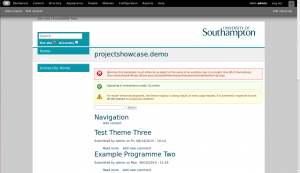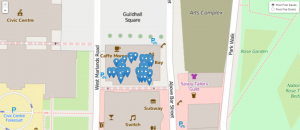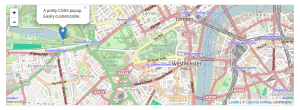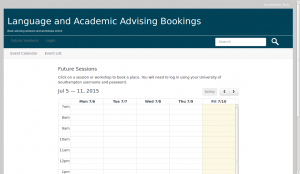Last weekend we went to UK Open Data Camp 2 in Manchester. This is an unconference so you don’t know quite what you’re going to get and it was indeed a mixed bag.
The very first session I attended was the most shaky. It was about asking the audience for feedback on an app their fire service was having developed. It would have worked OK with a smaller group or some facilitation, but had the misfortune to be at a time with only one other session. Hopefully the chap got something useful out of it. I’ve been to enough of these events to know the ‘law of two feet‘ and failed to enact it, so more fool I.
The session that I should have gone to was about a service someone had set up inspired by Open Data Camp 1 giving left over food to the nearby homeless shelter. The idea of his site is you can register as being interested in acceping left over fresh food. This means if some organisation has overcatered they can conveniently find a worthy use without having to think too hard about it. http://ediblegiving.org
I have a bunch of open-data training that I could give on different topics, and would quite have liked to but didn’t know the audience well enough to pitch something. My fear was ending up having to do a poorly attended session and having to miss something I could learn from. What would work better is if maybe we aimed to have more ‘speculative’ pitches which only run if there is enough interest.
One thing that I’ve not seen happen before at an unconference was that two sessions were so popular that they got declared spontaneous plenaries. One of these was about open data from DEFRA and the other was a history of the UK address (data) wars. This was a great decision from the organisers because I would have hated to run a competing session.
An interesting moment in the DEFRA session was where they asked if people wanted the cleaned and checked final-version data about river water levels or the raw current sensor data. Pretty much everyone who was interested wanted both and that theme recurred in a couple of other sessions. It’s OK to publish the same data in different ways for different audiences. If I’m buying a house or doing town planning then long term data on flood patterns is very useful. If I own a house by a river than real-time water-height data, even if it’s sometimes flawed, could save my carpets.
Making open data suck a bit less
At the end of the first day I ran a session called ‘making open data suck a little less’ which I think came out OK and people said some nice things on Twitter, but the frustration is (surprisingly) we’re not a very empowered community. I think the involvement of really big guns like government agencies means that everybody expects someone else to do stuff and it’s a bit intimidating.
I wanted to ensure that we got some suggestions of solutions as well as problems so we started by brainstorming what pisses us off about open data and then I tried to resolve that into some key areas and get people to suggest solutions. In the front row was Amadnda Smith, the Community Engagement Manager at the ODI (Open Data Institute) making lots of notes which was heartening.
The things which pissed us off included:
- restrictions on who can use the data, eg. acadmic only
- having to fill in forms to get data
- Javascript interfaces which make it hard to access the data directly and mechanically
- open data available only from an API rather than also providing a bulk download
- data not linked to related data, eg. you’ve found the 2012 street crime data for Basingstoke, but is there other 2012 data? Is there 2015 data for Basingstoke?
- formats without any clues of how to get started with them (Geodata, we’re looking at you)
- no licenses is a problem for people wanting to use the data more formally.
- data in CSV especially “O.N.S.Esque data”, a sarcastic nod to the office of national statistics less helpfully formatted spreadsheets.
- data supplied in PDF (sigh, people still do that)
- data supplied as a picture. Graphs, for example.
- non-intuitve XML structures.
The solutions were not as fun as the gripe session; I tried to boil the above frustrations down into broad sections. Some of them we didn’t have much idea of how to realisticly address.
- Frustrating Legal Stuff
- Frustrating Access
- a problem here is that the first time the community sees the user interface is usually after the development company have already finished the product. Release early, release often.
- Frustrating Formats
- For formats that might be opaque to newbies, it would be good for the community to have well known pages that can be linked to when you publish data in certain formats or APIs. The question is who does this? The ODI? OKFN? The Open Data Handbook?
- It would be very helpful for more obscure formats to tell people what tools and libraries exist, and to remember that your ‘standard format’ might well be baffling to others.
- One persons’s poor bad format choice is another person’s preference. It’s OK to publish data in more than one format.
- Promote tools like CSV Lint.
Since the event I have created a small page about LIDAR data which has some of the information I wish I’d had when I started.
Pub vs Resturant?
In the evening we ended up taking the ‘pub’ track rather than the ‘resturant’ track, and ended up with just me, Ash and a chap from the Isle of Man. I learned lots of interesting stuff about the Isle of Man – it’s less population that the Isle of Wight and has it’s own government and laws and would prefer to not be seen as a tax haven. I suggested they should make sure all their data is on open corporates (if it’s not already, I’m not sure). We did manage to catch up with some more delegates later in the evening.
I should also mention that this was not a great weekend to get a hotel in Manchester. There were several sports-ball events and Ash’s hotel room was expensive and ideal if you wanted to go to bed after attending the nightclub underneath until 4am (sorry Ash..). I was in the Premiere Inn. Fun fact: There are 6 Primiere Inns in Manchester. Another fun fact, all the buildings in Manchester are huge and solid and really screw up GPS so trust the street signs, not the GPS. Another tip for Manchester navigation; when dealing with canals stop and look at the map to make sure you’re on the right bank or you’ll end up backtracking.
Oh, and I’m still trying to work out who I borrowed £20 in the pub so I can pay them back (sorry about that, utterly forgot about it until I was on the way home)
Isle of Data
The next day I went to the session about what an open data service for the Isle of Man could/would/should look like. While technicially this was another ask-the-community-for-help session, it was far more interesting as it was about practical solutions and best practice. As someone who both creates and consumes open data I had lots of opinions and I did my best to let other people talk too, but my best wasn’t very good (sorry). Some interesting points that I remember:
- start with identifiers not datasets
- publish what you have already, but aim to make better datasets later (raw and cooked)
- make recurring publication plans clear so people can confidently build systems with confidence
- where possible make government departments communicate using open data methods
Some things I learned.
- I should have gone out and purchased a nicer jar of coffee than the gawdawful Nescafe. I could have stuck ‘sponsored by data.ac.uk’ on a jar of more expensive coffee granules and got some very cheap promotion.
- Provide a bit of guidance to help people new to unconferences think about what they should do in advance.
- For unconferences, let people request sessions as well as propose them
- Give some time after the pitches for people to mingle.
- Check sports fixtures if possible when planning a city event
- Trust read a map and street signs more than GPS
Thank-you to those who organised this. Please know that any negative comments are always about making it the best it can be, not complaints. I know how much work these things are to put on.
Also, the venue was excellent. Hardly worth mentioning as the worst thing about it was the chairs that were a bit too slopey to put my coffee on, all the other stuff was ideal for this kind of event.








